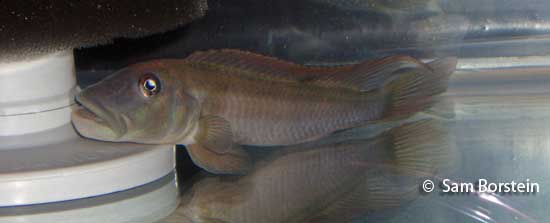Steatocranus tinanti
(Poll, 1939)
Slender Lion Head Cichlid
Synonyms: Gobiochromis tinanti, Leptotilapia tinanti

Above: A male Steatocranus tinanti. Photo by Sam Borstein.
Etymology:
Genus- Steato=fat (Greek), cranus= skull (Greek). Referring to the large heads of the fish.
Species- tin= stretch (Greek), antiae= forelock (Greek). Referring to the elongated look in the fish.
Intro:
Steatocranus tinanti is a rheophilic West African cave spawner that was first typed in 1939 by Max Poll. This riverine cave spawner is one of the most popular West African fish in the hobby right now, due to its peaceful nature and unique look.
Steatocranus tinanti, being a riverine cichlid has a reduced swim bladder, so instead of really swimming, these fish kind of just hop around the tank.
There has been some taxonomic confusion about this fish over the years. It was originally described as Gobiochromis tinanti and was later moved to the genus Leptotilapia (Lamboj, 2004). Although there is some argumentation between scientists on the position of this species in Steatocranus, it would not be surprising to see this fish moved back to Leptotilapia in the next revision of Steatocranus.
Distribution:
This fish is found through the lower stretches of the Congo River, specifically at Malebo pool, in fast flowing areas (Lamboj, 2004).
Size, Maturity, and Sexual Dimorphism:
Size: Males- 6 inches, Females- 4.5 inches
Maturity: 3 inches
Sexual Dimorphism: Males are larger, and have much longer fins than the females. Males also get a larger cranial profile.
Care:
Steatocranus tinanti is very easy to care for. This fish can tolerate soft and hard water and a pH that is neutral, or even on the higher basic side. They are peaceful and can be kept in a community tank with minimal issues. The only time I saw aggression from these fish were when they were defending their spawn. I never saw the male go after the female or any other fish unless they were on a spawn. This fish does best in pairs, but if the tank is large enough, a group can be kept. A breeder pair will do fine in a 20 gallon tank.
This fish mixes well with other mild cichlids as well as larger tetras and mild barbs.
Diet:
Steatocranus tinanti is omnivorous and is not a picky eater. It will accept almost anything in aquaria. Mine did well on a diet of spectrum, tetramin, and a spirulina flake.
Breeding:
Steatocranus tinanti is fairly easy to breed. The fish form excellent pair bonds. Steatocranus tinanti is a cave spawner, so give it some caves with small openings to entice the fish into spawning. Spawning is neat. The male displays to the female and escorts her into the cave.
The fish lay around 50-100 eggs, which are olive green in color and large. The eggs develop slow, and by 5 days hatch. At about 10-12 days post spawn, the fry are free swimming. They were easy to raise, especially on baby brine shrimp. The fry are large and grow quickly. After 2 months, they were nearing 1.5 inches. At this point, one can see a tilapia spot in the fish's dorsal fin.
Conclusion:
If you are just getting West Africans, this is a good starting fish. The fish lack in color, but they are peaceful, easy to keep, and display unique behavior. You will occasionally find this fish at pet shops, but you most likely will have to find a local breeder if you want these guys.
References:
- Lamboj, A. (2004). The Cichlid Fishes of Western Africa. Bergit Schmettkamp Verlag, Bornheim, Germany, 255 pp.
